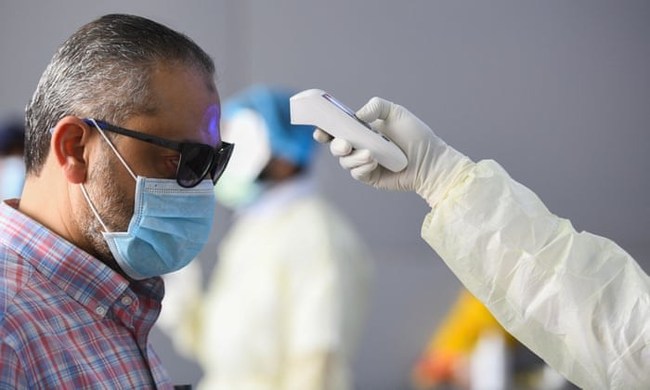In light of concerns about the spread of the novel coronavirus in the workplace, employers are confronting important questions pertaining to the screening of employees for COVID-19 symptoms, including as it pertains to taking employees’ temperatures: May (or must) we screen employees for fevers, and if so, how should we implement such a practice?
[ Learn more here... about our A.I. Powered Crowd Thermal Monitoring Solution - powered by BizCare ]
In Part 1 of this two-part blog series, we address issues relating to the decision of whether employers may (or must) implement a temperature screening protocol. In Part 2, we will provide guidance on how to do so.
Non-Discriminatory Temperature Screening Is Permitted
Taking an employee’s temperature is considered a medical exam under the Americans with Disabilities Act (“ADA”) and would normally be subject to strict restrictions. However, the federal Equal Employment Opportunity Commission (“EEOC”) has expressly stated in updated guidance that employers are permitted to screen employees for fevers due to the COVID-19 pandemic. Some state agencies are following suit; for example, the California Department of Fair Employment and Housing recently issued guidance indicating that temperature checks are permissible and non-discriminatory under the present circumstances, so long as they are conducted on all personnel entering a facility.
Federal Guidance Supports Temperature Screening In Certain Circumstances
At the federal level, the Centers for Disease Control and Prevention (“CDC”) has advised all employers to consider “community level spread” of COVID-19 when determining appropriate workplace precautions, stating that workplaces in communities with minimal to moderate community spreading should, among other things, “[c]onsider regular health checks (e.g., temperature and respiratory symptom screening) of staff and visitors entering buildings (if feasible).”
Recently, the CDC issued updated guidance directed at employers of “critical infrastructure workers”[1] who were or may have been exposed to a person suspected or confirmed to have COVID-19. The CDC takes the position that, if they are asymptomatic, those individuals do not have to self-isolate (i.e., stay at home and avoid the workplace) but are instead allowed to continue to come into the workplace, so long as their employers, among other things, measure their temperature and assess their symptoms daily prior to them starting work.
Although the federal Occupational Safety and Health Administration (“OSHA”) requires employers to provide a work environment free of recognized hazards that are causing or likely to cause death or serious physical harm, OSHA has not specifically addressed the issue of whether to conduct temperature screenings.
State And Local Guidance Regarding Temperature Screening Varies
At the state level, some states have not addressed the issue of temperature screening at all, while others have issued very specific guidance on the subject. For example, Ohio has issued guidance “strongly recommending” that each employee have their temperature taken every day before the start of the workday. If an Ohio employer cannot perform temperature checks due to an inability to acquire thermometers, the employer must implement a “screening questionnaire” each day, including asking employees if they have symptoms consistent with COVID-10 (fever, cough, shortness of breath). Any employee who reports a fever or other symptoms consistent with COVID-19, or who registers a temperature at or above 100.4 ° F during an employer-provided temperature check, should be sent home.
Going further, Delaware requires certain “high-risk businesses” (e.g., hospitals, childcare facilities) to implement screening questionnaires on a daily basis. Each employee must be asked about and report a body temperature at or above 99.5 ° F, and each employee must answer a daily questionnaire regarding additional COVID-19 symptoms. At the same time, if an employer “has the capability,” Delaware recommends performing temperature checks with a thermometer at the workplace, and provides guidance on best practices (e.g., using a touchless thermometer). Delaware “strongly recommends” that all employers implement screening procedures, even if the business is not included in Delaware’s list of “high-risk” businesses.
Some local governments are similarly requiring temperature screening procedures. For example, Oakland County, Michigan mandates that businesses and employers that remain open during the pandemic must develop and implement a “daily screening program.” A screening program must include questions regarding symptoms (fever, cough, sore throat), any close contact within the last 14 days with someone with a diagnosis of COVID-19, and any international or domestic travel within the last 14 days. As in Delaware, Oakland County “strongly recommends” that employers implement temperature checks with a touchless thermometer if available. Other local municipalities are deferring to the CDC on this issue, while generally encouraging social distancing measures in the workplace.
Certain businesses and workplaces (e.g., healthcare facilities, assisted living facilities, and courthouses) may be subject to additional screening requirements and protocols under state and local COVID-19 orders.
As the federal and local governments begin to turn their attention towards to goal of reopening workplaces and easing stay at home orders, it will be important for all employers to watch for changing guidance on this subject.
Employers Should Encourage Employees To Monitor Their Own Health
When deciding whether to implement temperature screening, it is important to remember that fever is not the only symptom of COVID-19, and sometimes is not present at all. Accordingly, even if a temperature screening protocol is adopted, employers should emphasize to employees that screening is not a substitute for monitoring their own symptoms and potential exposure. Employees who are “coming down” with something should stay home, even if they are fever-free, until they know if they have COVID-19, recover from any COVID-19 symptoms per the CDC guidelines, or are diagnosed by a healthcare professional with a non-contagious explanation for their symptoms. Neither employers nor employees should think of the temperature screening process as the sole means of determining whether employees are healthy enough to be at work.
The COVID-19 pandemic and its impact on the workplace is rapidly evolving. Employers should regularly consult with legal counsel, the CDC website, and state and local government “shelter-in-place” and related public health orders to ensure they have the most up-to-date information and guidance.



You must be logged in to post a comment.